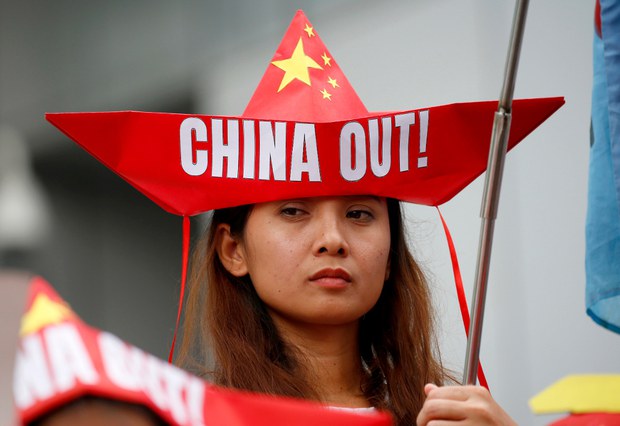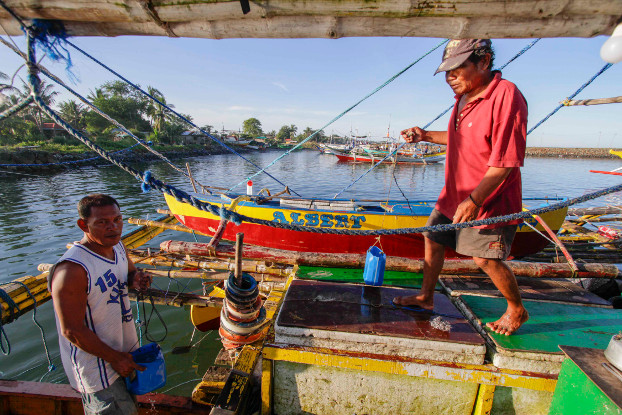Philippines Complains to Beijing about Reported Military Buildup in Disputed Sea Region
2018.05.17
Manila
 A Philippine protester wears a boat-shaped paper hat and holds a flag during a protest outside the Chinese Consulate in Makati city against Beijing’s alleged militarization of the disputed Spratly islands in the South China Sea, Feb. 10, 2018.
A Philippine protester wears a boat-shaped paper hat and holds a flag during a protest outside the Chinese Consulate in Makati city against Beijing’s alleged militarization of the disputed Spratly islands in the South China Sea, Feb. 10, 2018.
Through a “frank” discussion with Chinese officials the Philippines has raised concerns about China’s reported installation of missiles in the disputed Spratly islands, the government said Thursday.
Foreign Secretary Alan Peter Cayetano has assured the government that active mechanisms were in place to address growing concerns over China’s alleged militarization of the South China Sea, known in the Philippines as the West Philippine Sea, presidential spokesman Harry Roque said.
Roque, a former international lawyer who previously questioned China’s encroachment in the sea region, said Manila was not keeping mum about the perceived aggressive moves by Beijing.
“Secretary Cayetano told me personally that the department not only protested, but raised the issue of reported Chinese arms, airports and airplanes in those islands,” Roque said in a statement.
The government was approaching the issue not only by means of a diplomatic protest, but through an “open, frank, candid, and frontal discussion” with China, he said.
“We have relayed our position through this mechanism that we created to talk about this issue,” Roque said.
He did not say if China responded to the question.
Two weeks ago, the Philippines and the United States, its longtime military ally, expressed concerns over the development as they held annual joint military exercises.
China reportedly installed anti-ship cruise missile and surface-to-air missile systems on three islands in the Spratlys west of the Philippines. The mineral-rich region also is contested by Brunei, Malaysia, the Philippines, Vietnam and Taiwan.
Late last month, the Asia Maritime Transparency Initiative, a think-tank tracking maritime security issues in the region, published satellite photos showing a Shaanxi Y-8, a Chinese military transport plane, deployed at a base on Subi Reef in the Spratlys.
The plane can be used for maritime patrols and signals intelligence, according to the think-tank. The development, it said, should be particularly concerning for Manila considering the Philippines maintained a small contingent, including about 100 civilians, on Pag-asa Island, about 12 nautical miles (22.2 km) away. Pag-asa is called Thitu Island by the Chinese.
The report noted that military aircraft had also landed on all three of China’s airstrips in the Spratly chain, while a transport aircraft was spotted on Mischief Reef in early January.

Duterte says he knew of Chinese buildup
On Wednesday, President Rodrigo Duterte acknowledged that he knew of the Chinese military buildup in the region, but said there was little else he could do about this. Instead, he said, the Philippines would likely do better to keep the peace with Beijing.
“There is an airport. There are missiles installed [there]. There is military equipment already in place. So what’s the point of questioning whether the planes there land or not. There’s an airstrip,” Duterte said, according to transcripts released by the presidential palace.
He said he could “declare war” anytime, but warned that the Philippines would not win.
“I will discuss with you geopolitics and why I allow things to just stay there. You will not be able to drive them away, why would you quarrel with them?” he said.
“We will lose the battle,” he added. “I am 100 percent sure about that.”
Duterte said he had spoken with Chinese leader Xi Jinping, who advised him the two countries should keep the communication lines open.
“What was the reply of President Xi? He said, ‘We just restored normalcy. It would not be good for us to be talking [of], you know, conflict,’” Duterte recounted. “’Let’s talk about that some other time.’”
He said he told Xi that he would raise the issue of an international arbitration ruling over contending Chinese and Philippine territorial claims in the sea before his six-year term expired. The Chinese side had refused to speak with his immediate predecessor, Benigno Aquino III, about it.
Duterte did not say when the exchange took place, but he had travelled to China in April to attend a business forum, during which, the palace said, he had an opportunity to meet with Xi.
The Chinese government, through its embassy, did not respond to calls from BenarNews.
Aquino’s government had taken Beijing to the Permanent Court of Arbitration, which ruled in favor of the Philippines in 2016, when Duterte was already the president.
Duterte, however, had previously sought to pin the blame on Aquino, whom he had erroneously said was still president when the arbitration ruling was handed down.
Felipe Villamor in Manila, Karl Romano in Dagupan City and Dennis Jay Santos Davao City, Philippines, contributed to this reported.








